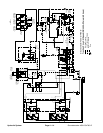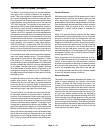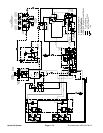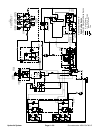
Groundsmaster 4500--D/4700--D Hydraulic SystemPage 4 -- 15
Traction Circuit: HI Speed (Transport)
The traction circuit piston pump is a variable displace-
ment pump that is directly coupled to the engine fly-
wheel. This pump utilizes an integral electro--hydraulic
servo piston assembly that controls the rate and direc-
tion of hydraulic flow. Pressing the traction pedal rotates
a potentiometer that provides an input to the machine
TEC--5002 controller. The controller in turn sends a cor-
responding PWM (Pulse Width Modulation) output to
the electronic pump control to rotate the pump swash
plate accordingly to control pump output and direction.
Traction circuit oil is directed to the dual displacement
front wheel and rear axle motors. Operating pressure on
the high pressure side of the closed traction circuit loop
is determined by the amount of load developed at the
wheel and axle motors. As the traction load increases,
circuit pressure can increase to relief valve settings:
4350 PSI (300 bar) in forward and 5000 PSI (345 bar)
in reverse. If traction circuit pressure exceeds the relief
setting, oil flows through the piston pump relief valve to
the low pressure side of the closed loop traction circuit.
Front wheel and rear axle motors are positive displace-
ment, two speed variable motors. The dual displace-
ment wheel and axle motors allow operation in either
LOW (mow) or HI (transport) speed. The motors are
spring biased tomaximum displacementfor LOW speed
and are hydraulically shifted to m inimum displacement
for HI speed. The rear a xle motor includes a flushing
valve that bleeds off a small amount of hydraulic oil for
cooling of the closedloop traction circuit. Thecharge cir-
cuit replenishes oil that is bled from the traction circuit by
theflushingvalve.
An optional traction circuit flow divider is available that
equally splits traction pump flow between the front
wheel motors and rear axle motor to prevent excessive
circuit flow going to a spinning wheel. If equipped, the
front traction manifold which includes the flow divider is
mounted to the right, rear side of the front frame.
The piston pump, front wheel motors and rear axle mo-
tor use small amounts of hydraulic fluid for internal lu-
brication. Fluid is designed to leak across traction pump
and motor components into the case drain. This leakage
results in the loss of hydraulic fluid from the closed loop
traction circuit that must be replaced. The charge circuit
is designed to replace this traction circuit leakage. The
gear pump section that supplies oil to the steering and
lift/lower circuits also provides oil for the charge circuit.
Gear pump flow for the charge circuit is directed through
the oil filter and to the low pressure side of the closed
loop traction circuit. Charge pressure is limited to 250
PSI (17 bar) by a relief valve located in the piston pump.
Forward Direction
WiththearmrestconsoleHI/LOWspeedswitchintheHI
speed (transport) position, the solenoid valve in the HI/
LOW range control manifold is energized. This ener-
gized solenoid valve directs charge pressure to shift the
front wheel motors and rear axle motor to their minimum
displacement. With the motors at their minimum dis-
placements, a faster traction speed is available for
transport.
When in HI speed (transport) position with the traction
pedal pushed in the forward direction, oil from the piston
pump oil is directed to the front wheel motors and rear
axle motor through a parallel system. Oil flow to the front
wheel motors drives the motors in the forward direction
and then returns to the piston pump. Oil flow to the rear
axle motor drives the motor in the forward direction. Oil
returning from the axle motor enters the rear traction
manifold at the M8 port. Flow bypasses the PR cartridge
through the CV check valve, out manifold port P2 and re-
turns to the piston pump.
When going down a hill, the tractor becomes an over--
running load that drives the front wheel and rear axle
motors. In this condition, the rear axle motor could lock
up as the oil pumped from the motor increases pressure
as it returns to the piston pump. To prevent rear wheel
lock up, an adjustable relief valve (RV) in the rear trac -
tion manifold reduces rear axle motor pressure created
in down hill, dynamic braking conditions.
Reverse Direction
The traction circuit operates essentially the same in re-
verse HI speed (transport) as it does in the forward
direction. However, the flow through the circuit is re-
versed. Oil flow from the piston pump is directed to the
front wheel motors andalso to the rear tractionmanifold.
The oil to the front wheel motors drives them in the re-
verse direction and then returns to the piston pump. The
oil to the rear traction manifold enters the manifold at
port P2 and flows through pressure reducing valve (PR)
which limits the down stream pressure to the rear axle
motor to 450PSI (31bar) so the rear wheelswill notscuff
the turf during reverse operation. This reduced pressure
flow isdirected out rear tractionmanifold port M8 tod rive
the rear axle motor in reverse. Return oil from the rear
motor returns to the piston pump.
Hydraulic
System


















